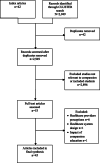What works for whom in compassion training programs offered to practicing healthcare providers: a realist review
- PMID: 34454489
- PMCID: PMC8403363
- DOI: 10.1186/s12909-021-02863-w
What works for whom in compassion training programs offered to practicing healthcare providers: a realist review
Abstract
Background: Patients and families want their healthcare to be delivered by healthcare providers that are both competent and compassionate. While compassion training has begun to emerge in healthcare education, there may be factors that facilitate or inhibit the uptake and implementation of training into practice. This review identified the attributes that explain the successes and/or failures of compassion training programs offered to practicing healthcare providers.
Methods: Realist review methodology for knowledge synthesis was used to consider the contexts, mechanisms (resources and reasoning), and outcomes of compassion training for practicing healthcare providers to determine what works, for whom, and in what contexts.
Results: Two thousand nine hundred ninety-one articles underwent title and abstract screening, 53 articles underwent full text review, and data that contributed to the development of a program theory were extracted from 45 articles. Contexts included the clinical setting, healthcare provider characteristics, current state of the healthcare system, and personal factors relevant to individual healthcare providers. Mechanisms included workplace-based programs and participatory interventions that impacted teaching, learning, and the healthcare organization. Contexts were associated with certain mechanisms to effect change in learners' attitudes, knowledge, skills and behaviors and the clinical process.
Conclusions: In conclusion this realist review determined that compassion training may engender compassionate healthcare practice if it becomes a key component of the infrastructure and vision of healthcare organizations, engages institutional participation, improves leadership at all levels, adopts a multimodal approach, and uses valid measures to assess outcomes.
Keywords: Clinicians; Compassion; Education; Healthcare providers; Nurses; Training.
© 2021. The Author(s).
Conflict of interest statement
The authors declare that they have no competing interests.
Figures


Similar articles
-
The initial validation of an Evidence-informed, competency-based, Applied Compassion Training (EnACT) program: a multimethod study.BMC Med Educ. 2024 Jun 21;24(1):686. doi: 10.1186/s12909-024-05663-0. BMC Med Educ. 2024. PMID: 38907199 Free PMC article.
-
What Is the State of Compassion Education? A Systematic Review of Compassion Training in Health Care.Acad Med. 2021 Jul 1;96(7):1057-1070. doi: 10.1097/ACM.0000000000004114. Acad Med. 2021. PMID: 33830949 Free PMC article.
-
Compassion training in healthcare: what are patients' perspectives on training healthcare providers?BMC Med Educ. 2016 Jul 11;16:169. doi: 10.1186/s12909-016-0695-0. BMC Med Educ. 2016. PMID: 27401015 Free PMC article.
-
Healthcare providers perspectives on compassion training: a grounded theory study.BMC Med Educ. 2020 Aug 5;20(1):249. doi: 10.1186/s12909-020-02164-8. BMC Med Educ. 2020. PMID: 32758216 Free PMC article.
-
Compassion: a scoping review of the healthcare literature.BMC Palliat Care. 2016 Jan 19;15:6. doi: 10.1186/s12904-016-0080-0. BMC Palliat Care. 2016. PMID: 26786417 Free PMC article.
Cited by
-
Mindfulness-based interventions to support wellbeing of adults in low socio-economic settings: a realist review.BMC Complement Med Ther. 2024 Jan 24;24(1):52. doi: 10.1186/s12906-023-04263-7. BMC Complement Med Ther. 2024. PMID: 38267955 Free PMC article. Review.
-
A systematic realist synthesis of digital interventions for enhancing mental health at work: contexts, mechanisms, and outcomes.Int J Ment Health Syst. 2025 Jan 9;19(1):3. doi: 10.1186/s13033-024-00655-5. Int J Ment Health Syst. 2025. PMID: 39780192 Free PMC article. Review.
-
Development of a training programme to improve health literacy and respectful compassionate care competencies among undergraduate student nurses: a quantitative study.BMC Med Educ. 2025 Mar 6;25(1):348. doi: 10.1186/s12909-025-06894-5. BMC Med Educ. 2025. PMID: 40050847 Free PMC article.
-
Advisory groups in realist reviews: Systematically mapping current research and recommendations for practice.Cochrane Evid Synth Methods. 2024 Jun 11;2(6):e12073. doi: 10.1002/cesm.12073. eCollection 2024 Jun. Cochrane Evid Synth Methods. 2024. PMID: 40475884 Free PMC article. Review.
-
Using Positive Deviance to Enhance HIV Care Retention in South Africa: Development of a Compassion-Focused Programme to Improve the Staff and Patient Experience.Res Sq [Preprint]. 2024 Sep 5:rs.3.rs-4882407. doi: 10.21203/rs.3.rs-4882407/v1. Res Sq. 2024. Update in: BMC Glob Public Health. 2025 Feb 6;3(1):8. doi: 10.1186/s44263-025-00123-3. PMID: 39281882 Free PMC article. Updated. Preprint.
References
-
- Sinclair S, Hack TF, Raffin-Bouchal S, McClement S, Stajduhar K, Singh P, et al. What are healthcare providers’ understandings and experiences of compassion? The healthcare compassion model: a grounded theory study of healthcare providers in Canada. BMJ Open. 2018;8(3):e019701. doi: 10.1136/bmjopen-2017-019701. - DOI - PMC - PubMed
-
- Institute of Medicine . In: Improving medical education: enhancing the behavioral and social science content of medical school curricula. Cuff PA, Vanselow NA, editors. Washington (DC): National Academies Press (US); 2004. - PubMed
Publication types
MeSH terms
Grants and funding
LinkOut - more resources
Full Text Sources

